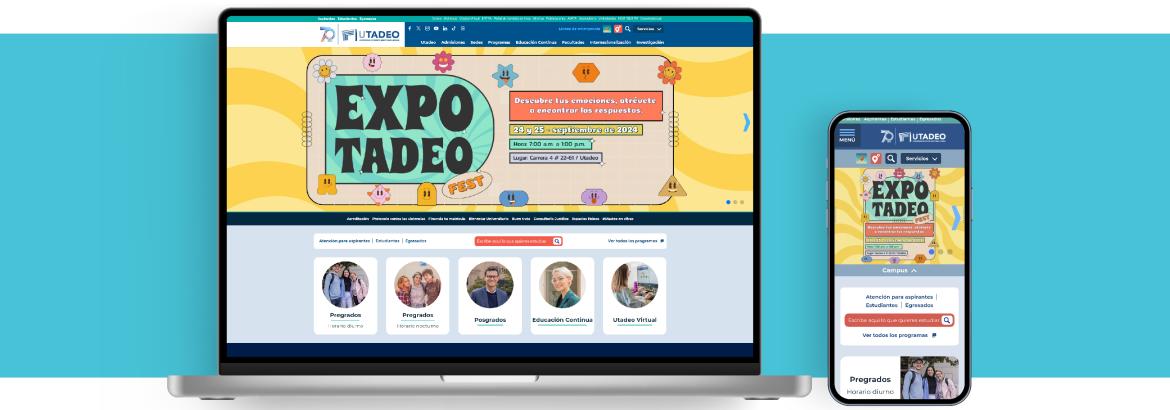
Promoviendo el uso de nuevas tecnologías
La Universidad Jorge Tadeo Lozano es una universidad privada colombiana con sede en la ciudad de Bogotá.
Antecedentes
La Universidad no contaba con herramientas y servicios tecnológicos que facilitaran la administración de sus sitios web y la producción y actualización de sus contenidos digitales. Las herramientas utilizadas no permitían poner en marcha un proceso de publicación organizado en el que pudieran participar diferentes actores y a partir del cual se pudieran establecer pautas de estandarización y una arquitectura de la información alineada con la estrategia integral de presencia digital de la Universidad.
Tras realizar un análisis de la situación del soporte tecnológico de los servicios web de la Universidad, y con el fin de garantizar el éxito de la implantación de la estrategia Tadeo Digital, surgió la necesidad de disponer de una plataforma de gestión de contenidos y de servicios de consultoría y tecnológicos asociados que garantizaran su mantenimiento y funcionamiento ininterrumpido.
¿Por qué fue escogido Drupal 7 para este proyecto?
La Universidad llevó a cabo una evaluación de las plataformas de gestión de contenidos que mejor se adaptaban a sus necesidades y, en particular, a la estrategia del proyecto Tadeo Digital. La evaluación se realizó teniendo en cuenta criterios de facilidad de uso, robustez tecnológica, servicios de soporte o consultoría y costos.
De la evaluación se concluyó que de todas las plataformas y servicios evaluados y según los criterios establecidos, la que mejor se adaptaba a las necesidades de la Universidad era Drupal 7 dada la relación de mayor robustez y mayor facilidad de uso.
Descripción del proyecto
Objetivos:
La Universidad Jorge Tadeo Lozano desarrolló el proyecto Tadeo Digital, con el que se pretendía fomentar el uso y aprovechamiento de las nuevas tecnologías y los lenguajes digitales como principal herramienta de información, comunicación e interacción con la Comunidad Tadeísta, el país y el mundo.
El objetivo general del proyecto era dotar a la Universidad de una presencia digital convirtiendo sus sitios web en la principal puerta de entrada a sus servicios, productos y contenidos en línea para posicionar y facilitar la interacción con la comunidad y el mundo.
Para alcanzar estos objetivos, se plantearon a su vez objetivos específicos:
-
Hacer del sitio web de la Universidad el principal medio de comunicación para dar a conocer sus principios, fortalecer su identidad, crear sentido de pertenencia y posicionar la marca.
-
Facilitar el acceso a sus servicios, oferta académica y producción científica y artística de forma ágil y moderna.
-
Convertir el sitio web institucional en el medio a través del cual se reconozcan y valoren los logros institucionales y personales de la Comunidad Tadeísta.
-
Promover la producción académica digital y facilitar su referenciación a nivel nacional e internacional.
-
Aprovechar las nuevas tecnologías para generar una comunidad participativa y colaborativa que construya conocimiento en beneficio de la sociedad.
-
Promocionar la oferta académica de cada facultad y programa, sus diferenciadores, valores, metodologías y la calidad de su personal docente e investigador.
Resultados
Tras un estructurado proceso de definición, se entró en la fase de desarrollo en la que se integraron todos los componentes necesarios, así como la estrategia de uso de Drupal 7 como gestor de contenidos, imprescindible para manejar grandes cargas de información tal y como era necesario en este caso.
Entre las principales características que se incluyeron se encuentran las estructuras dinámicas que ayudaron a dar un mejor manejo del portal a los administradores, favoreciendo en gran proporción la generación de micrositios. Esto ayudó considerablemente a dar mayor versatilidad a la creación de urls y banners publicitarios.
En cuanto a los módulos, podemos destacar que fueron gestionados en base a un estándar de programación flexible que permite una completa adaptabilidad a las necesidades de la Universidad. Por supuesto, no podemos dejar de lado uno de los más importantes, el que gestiona toda la parte de envíos masivos y «newsletter». Es importante resaltar que esto generó mayor libertad en el almacenamiento de las bases de datos de la institución.
En cuanto a la recolección y migración de la información, cabe señalar que evolucionó para ser mucho más dinámica entre los nodos, depurando así los procesos internos y los contenidos con mayor velocidad.
La atención entre usuarios finales ayudó a descentralizar la información, dando así los permisos necesarios para la generación de contenidos de una forma más sencilla e intuitiva. Todo ello enmarcado en la gran capacidad que ofrece Drupal CMS.
Los responsables del proyecto en la Universidad Jorge Tadeo Lozano afirman lo siguiente:
-
Utilizamos la distribución de Drupal 7 creada en SeeD (SeeD Dist alpha5).
-
Uno de los puntos estratégicos del proyecto Tadeo Digital ha sido la recopilación de información muy clara y detallada por parte de las personas involucradas en el proyecto para que ésta se traduzca en funcionalidades y tipos de contenidos relevantes para los usuarios.
-
Se han implementado estructuras altamente dinámicas y flexibles dentro del portal, lo que ha facilitado la creación de micrositios, "landing pages" y banners publicitarios.
-
Los módulos generados manejan un estándar de programación que permite adaptarse al dinamismo deseado en el portal.
-
Una de las cosas que más ha llamado la atención de los usuarios finales es la posibilidad de descentralizar la información, dando a cada uno los permisos necesarios para generar contenidos de una forma muy sencilla e intuitiva.
-
Uno de los módulos más activos y que ha marcado una gran diferencia con respecto a la plataforma anterior es el módulo de boletines; un módulo muy completo que les permite personalizar boletines o utilizar plantillas preestablecidas y estar en contacto permanente con la comunidad estudiantil.
Para la Universidad Jorge Tadeo Lozano ha sido un cambio fundamental en la orientación de su estrategia digital y Drupal se ha convertido en un gran aliado en este cambio.
